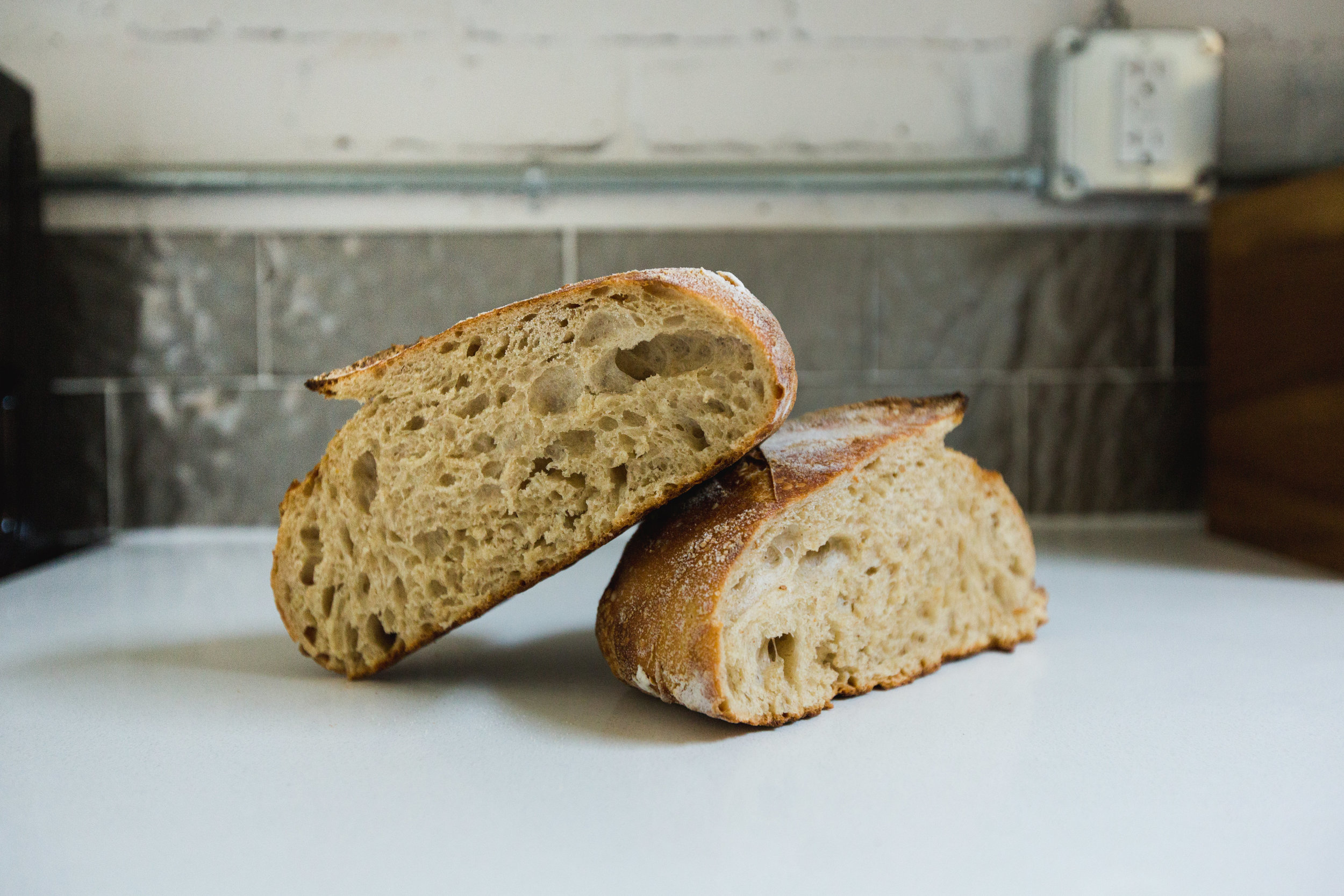Basic Sourdough Loaf Recipe
I’m going to start out by being completely honest with you: baking sourdough isn’t for everyone. But, if you choose to do it, I promise you will fall in love with it.
I began baking sourdough in 2014 and it completely captivated my heart. It is an engaging, yet challenging process that nudged me to work with my hands and yields an incredibly rewarding result. A combination of a science and an art, artisan sourdough is a subject that, should you decide to pursue it, will never be exhausted.
There are infinite ways to bake a loaf of sourdough. You can play with the hydration, flavors, method of bulk fermentation, temperatures, flour types, techniques of folding—the list goes on and on.
But, my biggest tip for someone just beginning their journey in sourdough is to start simply.
It’s so important to practice the basics and get the feel of things before experimenting with more variables, and so this is my basic sourdough loaf recipe, my go-to when I’m wanting to keep things simple!
The Basics Of Sourdough Bread
Artisan sourdough is bread that is baked without commercial yeast through the activity of wild yeast that has been cultivated through a starter. The starter is incorporated with flour, water and salt and then stretched and folded periodically over a couple of hours to strengthen the gluten in the dough.
This recipe assumes you have a healthy starter on hand. If you haven’t begun that process, check out my no-measure method for creating & maintaining a starter. Or if you want a more scientific guide that goes into even more depth into this process, check out this post.
The following recipe yields a single loaf, making it a great beginner recipe for artisan sourdough because you don’t have to work with too much dough.
If this is your first time baking, be aware, the dough will be incredibly sticky and seem difficult to work with. Wetting your hands before and during the process of working with the dough is a great trick to keeping it from sticking to your hands.
Be sure to watch the videos I link to in the recipe that will really help you in forming the loaves.
If you’re looking for a more in-depth process that walks you through all of the supplies you need, creating and maintaining a starter and making a double batch of bread, click here.

Basic Sourdough Loaf
Step by step instructions for making sourdough bread from the comfort of your own kitchen.
ingredients
- Bench Knife
- Bread Baskets with Linen Liners -or- Colanders Lined with Lint-Free Kitchen Towels
- Large Bowl
- Kitchen Scale
- Dutch Oven or Combo Cooker
- Razor blade or Bread Lame
- 25g mature starter
- 50g white flour
- 50g wheat flour
- 100g water
- 400g White Flour
- 100 Wheat Flour
- 375g + 25g Water
- 100g Leaven
- 10g Salt
- Rice Flour For Dusting
instructions
- The night before you plan to bake you need to create your leaven, which is an offshoot of your active starter. It’s a low concentration of yeast and a high concentration of flour and water, which results in bread with a mildly delicious sourdough flavor. Feel free to experiment with using a leaven, or your starter on its own.
- Place container on scale and add 25g of mature starter.
- Zero out scale and add 50g white, 50g wheat & 100g room temperature water.
- Mix thoroughly, lightly cover, and let develop overnight.
- The next morning, your leaven should be very active and be doubled in size.
- Autolyse is a process by which flour and water are added together without any other bread ingredients so that the flour fully hydrates and develops gluten without having to knead the dough. It also starts to break down the flour into starch that will feed your yeast. The benefit of this step that we’re letting time & water develop our gluten for us without so that we don’t over work the dough. The result is a dough that is easier to shape and work with.
- In a large bowl, combine your flours with 375g water. Use your hands to mix the dough until it just comes together in a shaggy ball and no dry bits remain. Cover and let set for at least 1hour and up to 3 hours.
- After the resting period, add 100 of your ripened leaven, 25g of water and 10g salt to your dough. Incorporate it all together by squeezing dough with your hands, until water, leaven & salt have absorbed. Cover and let rest for 30 minutes.
- During bulk fermentation we are letting the yeast ferment the dough, while at the same time working our dough to develop gluten and create a strong internal structure that can hold the network of bubbles the yeast will produce.
- Every half hour for 3-4 hours, perform a series of stretching & folding “turns” with your dough. Gently pull the edges of the dough up an over itself, working your way around the dough and rotating your bowl as you go. Then cover and let the dough rest
- Repeat this process every 30 minutes for 3-4 hours. The warmer your kitchen the faster your bulk. If you want to speed up the process you can store your dough in the oven with the light on or on near your dryer if it happens to be running.
- At the end of this process, your dough should have about doubled in size and have developed a smooth glossy surface.
- Lightly flour your work surface and pour your dough out into one solid mass. Fold your dough in half so that half of the floured side is now facing up and the sticky side is concealed within the fold.
- To form your dough into rounds, with the bench knife close to parallel to your work bench, lightly push the loaf under itself using a circular motion. This is creating tension on the top of the loaf which forms a smooth surface.
- See video for reference.
- Cover with a tea towel & let rest for 30 minutes.
- During this process we are setting the stage for the final shape or the loaves and developing the gluten further.
- Flour the top of your loaf and use your bench knife to scoop it up and flip it over, floured side down. Perform a series of folds as shown in the video: bottom to top, left to right, right to left, top to bottom. And then position the loaf so your seam is down, against your work surface.
- Twist the loaf against your work surface with your hands a few times to seal the bottom and create more tension along the top of the loaf.
- Video For Reference
- Dust a lined proofing basket with rice flour, or line a clean kitchen towel with rice flour and place into a colander.
- Pick up the loaf by scooping it up with your bench knife and flip it upside down into your proofing basket lined with a towel that has been floured with rice flour & cover with a clean towel.
- Cover loaves and let rest for 3-4 hours on your countertop, or overnight (up to 18 hours) in the fridge. If you must speed up this final rise you can turn your oven on for a minute or two, then turn it off and store your loaf in the closed oven.
- You can slow down the process by doing a slow, cold fermentation, also called retarding the dough, by proofing the dough in the fridge overnight which leads to a more flavorful dough due to a slower fermentation.
- Place dutch oven or combo cooker in oven and preheat to 500 degrees.
- When preheated, take loaf out of fridge (if using) and flip loaf over into dutch oven, so the part of the loaf that was facing down is now facing up in your pan.
- CAREFULLY score top of loaf with lame or razor blade, cover with lid and place in oven. Reduce heat to 450 degrees. Bake 20 minutes covered, and 20 minutes uncovered.
- Remove loaf from oven and place on cooling rack to cool.










Here are my top tips for keeping your sourdough starter happy and healthy.